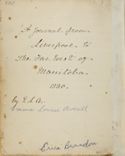
Rearview

About the Journal
 |
- The writing of the journal
- How did the journal come to the Archives of Manitoba?
- Some important questions remain
Emma Louisa Averill wrote "A Journal from Liverpool to the Far West of Manitoba 1880" as a reminiscence of her experiences traveling to and settling on a homestead in Manitoba, near present-day Clanwilliam. The journal is an overview of a full year, April 1880 to May 1881, beginning with the Averill family's departure from Liverpool, England to one year later experiencing their first spring on their homestead. Emma indicates that she is writing the journal to be read by people in the "Old Country", particularly for those interested in making a similar move to Canada.
Emma Averill structured her journal as a book, with 15 chapters covering such topics as "Crossing the Atlantic," "Ninety Miles in an Ox Wagon" and "Springtime". Emma's final chapter is a conclusion, in which she reflects on her year, particularly her new life on the Canadian prairie. Additionally, this chapter is particularly directed to others in England who might be convinced to take the same course.
The original diary was written in ink in a plain black notebook. See more information in the Keystone Archives Descriptive Database.
At the end of the last chapter, Emma gives some detail on the writing of the journal: "Before laying down my pen I must own that my journal was not continual after we left Lakefield so that the latter part of this is written entirely from memory, excepting that I referred to my husband's short diary for the exact dates and hours of our journey from Winnipeg and I would beg of those inclined to criticise severely its many imperfections to remember that it is written from a log shanty 16' x 14' where four children are doing their lessons and with my attention constantly divided between baking, churning, cooking, washing, and every other domestic duty and that which now lies before you."
Emma's journal is definitely not a diary and it should not be read as one. Her writing is directed at an English audience of, perhaps, family and friends. She is writing to inform, to entertain and, it seems, to persuade. The journal does not give a daily account, although some dates and events are written about in great detail. Emma's writing is generally optimistic and it is impossible to know how true a reflection this is of her feelings. Finally, many of the details are de-personalized in Emma's account, lacking specifics such as the names of her husband, sister and children.
How did the journal come to the Archives of Manitoba?
As with many of our acquisitions, there is a story behind the journal's arrival at the Archives. There are also several unanswered questions.
Emma Averill wrote her journal for family and friends in England. It appears the journal was sent to England but we do not know who received it, who read it or how widely it was distributed. At some point, the journal was returned to the Averill family in Canada. A few things happened with the journal after its return. A friend of the family, Laly (Latimer) Denison, Managing Director of Smith, Fess & Denison, read the journal and took it to his place of work, and had his secretary produce a transcript. This transcript was typed and then reproduced on mimeograph, the result being a rather blurry typescript on onion skin paper. Copies were given to several people and one copy was deposited, it seems, at the Legislative Library of Manitoba. The transcription recorded the author simply as E.L.A. so it was not known who wrote the journal, only that it was a story of a homesteader who settled near Minnedosa. Eventually, this transcript was transferred from the Legislative Library to the Archives of Manitoba.
Meanwhile, in 1983, Pax Crawley, grandson to Emma Averill brought the original journal to the Archives of Manitoba for microfilming. Later, in 1984, he deposited the original journal at the Archives of Manitoba. Archivists discovered the connection between the transcript and the original, thus settling one mystery and identifying E.L.A. as Emma Louisa Averill.
Some important questions remain
What happened to the journal after Emma Averill finished writing it? To whom did she send it? How widely was it shared and read in England? Who sent it back to Canada, and when? Did Emma's writing convince others to leave England and find a new home in Canada?
The journal records just one year in Emma's life. Find out more about what happened to Emma and her family in the years after the journal was written.
Find out more… search Emma Averill in the Keystone Archives Descriptive Database.
 Read Emma's Journal
Read Emma's Journal